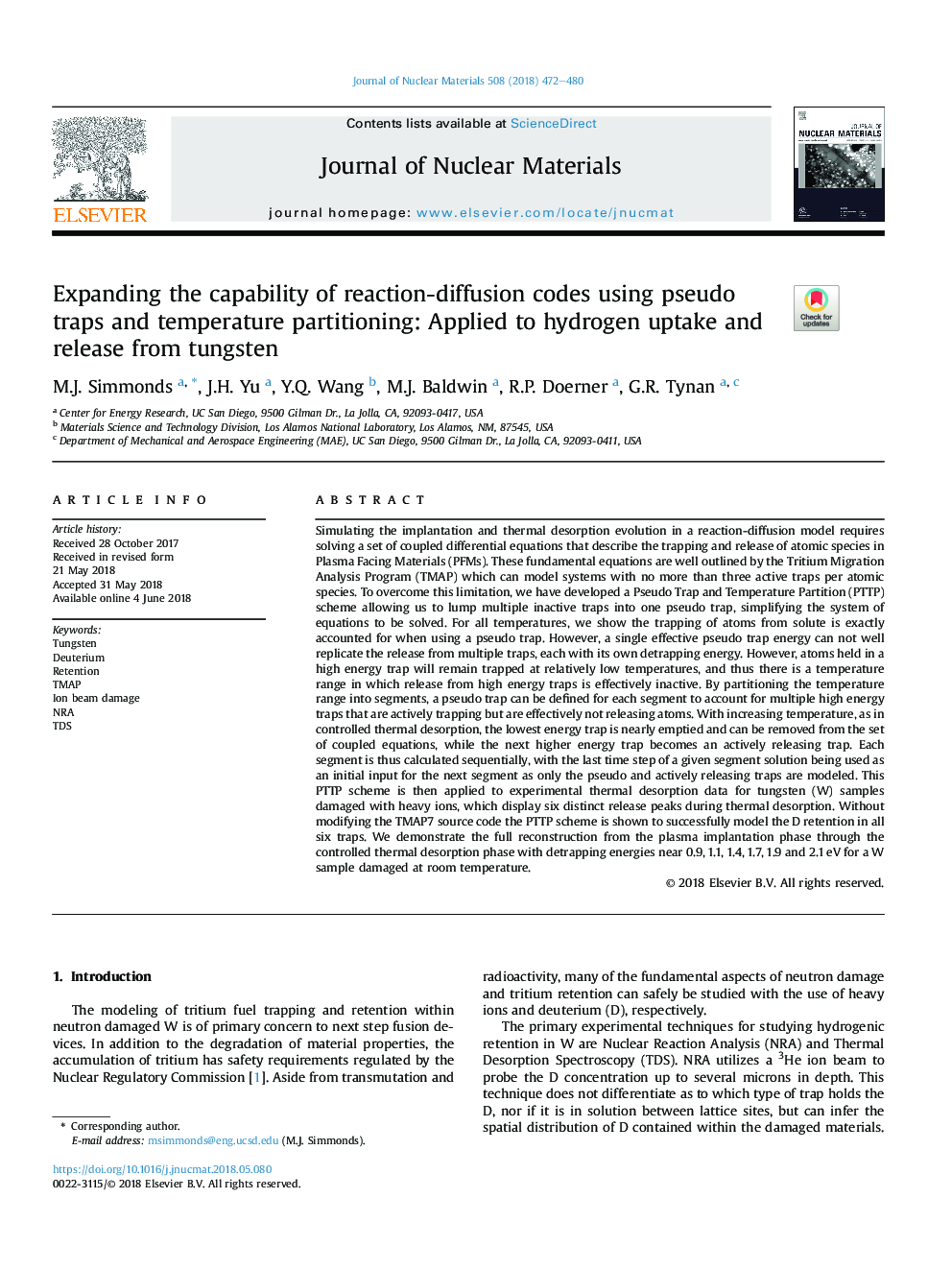| کد مقاله | کد نشریه | سال انتشار | مقاله انگلیسی | نسخه تمام متن |
|---|---|---|---|---|
| 7963075 | 1514138 | 2018 | 9 صفحه PDF | دانلود رایگان |
عنوان انگلیسی مقاله ISI
Expanding the capability of reaction-diffusion codes using pseudo traps and temperature partitioning: Applied to hydrogen uptake and release from tungsten
ترجمه فارسی عنوان
گسترش قابلیت کدهای واکنش انتشار با استفاده از تله های شبه ای و پارتیشن بندی درجه حرارت: به جذب هیدروژن و انتشار از تنگستن
دانلود مقاله + سفارش ترجمه
دانلود مقاله ISI انگلیسی
رایگان برای ایرانیان
کلمات کلیدی
موضوعات مرتبط
مهندسی و علوم پایه
مهندسی انرژی
انرژی هسته ای و مهندسی
چکیده انگلیسی
Simulating the implantation and thermal desorption evolution in a reaction-diffusion model requires solving a set of coupled differential equations that describe the trapping and release of atomic species in Plasma Facing Materials (PFMs). These fundamental equations are well outlined by the Tritium Migration Analysis Program (TMAP) which can model systems with no more than three active traps per atomic species. To overcome this limitation, we have developed a Pseudo Trap and Temperature Partition (PTTP) scheme allowing us to lump multiple inactive traps into one pseudo trap, simplifying the system of equations to be solved. For all temperatures, we show the trapping of atoms from solute is exactly accounted for when using a pseudo trap. However, a single effective pseudo trap energy can not well replicate the release from multiple traps, each with its own detrapping energy. However, atoms held in a high energy trap will remain trapped at relatively low temperatures, and thus there is a temperature range in which release from high energy traps is effectively inactive. By partitioning the temperature range into segments, a pseudo trap can be defined for each segment to account for multiple high energy traps that are actively trapping but are effectively not releasing atoms. With increasing temperature, as in controlled thermal desorption, the lowest energy trap is nearly emptied and can be removed from the set of coupled equations, while the next higher energy trap becomes an actively releasing trap. Each segment is thus calculated sequentially, with the last time step of a given segment solution being used as an initial input for the next segment as only the pseudo and actively releasing traps are modeled. This PTTP scheme is then applied to experimental thermal desorption data for tungsten (W) samples damaged with heavy ions, which display six distinct release peaks during thermal desorption. Without modifying the TMAP7 source code the PTTP scheme is shown to successfully model the D retention in all six traps. We demonstrate the full reconstruction from the plasma implantation phase through the controlled thermal desorption phase with detrapping energies near 0.9, 1.1, 1.4, 1.7, 1.9 and 2.1â¯eV for a W sample damaged at room temperature.
ناشر
Database: Elsevier - ScienceDirect (ساینس دایرکت)
Journal: Journal of Nuclear Materials - Volume 508, September 2018, Pages 472-480
Journal: Journal of Nuclear Materials - Volume 508, September 2018, Pages 472-480
نویسندگان
M.J. Simmonds, J.H. Yu, Y.Q. Wang, M.J. Baldwin, R.P. Doerner, G.R. Tynan,
